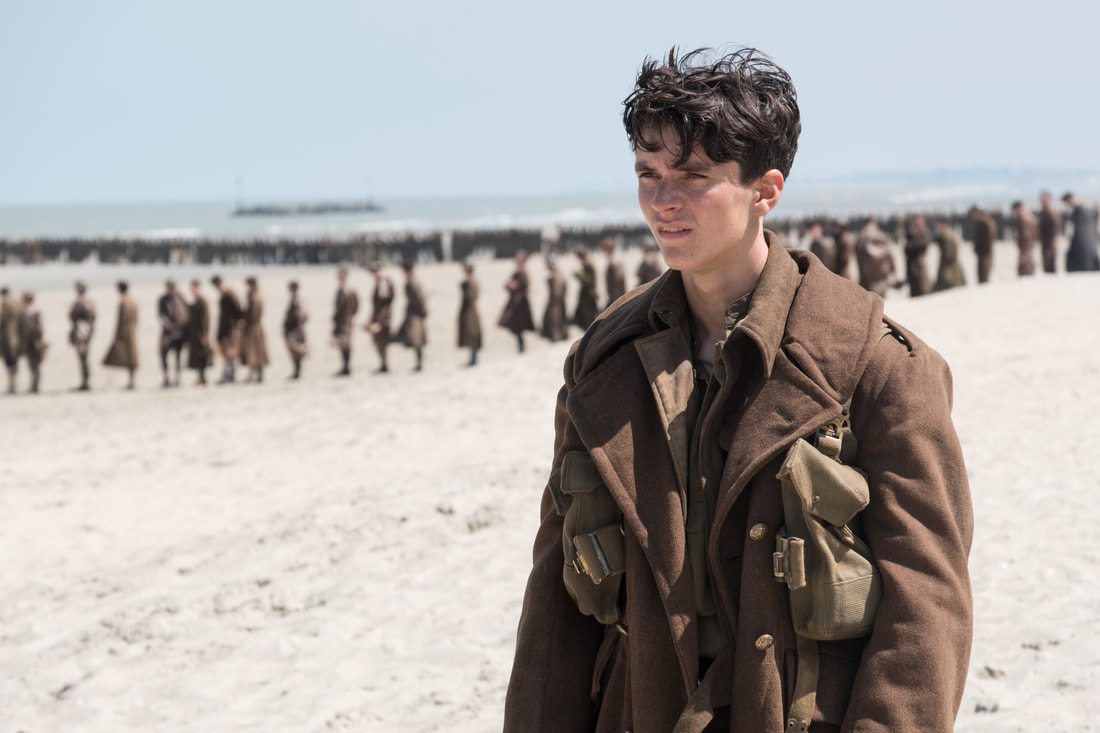In each timeline, Nolan adds a ticking-clock element that presents itself in the score as well as onscreen. Hans Zimmer incorporates the sound of a watch, compounding the ever-crunching boot on the characters’ throats and the viewers’ by extension. Mr. Dawson picks up a shell-shocked, marooned soldier (Cillian Murphy) who functions as a violent time bomb once he’s onboard. Farrier’s fuel gauge is broken during a skirmish and his squadmates keep getting shot down, leaving him increasingly alone and unsure of how long he can keep flying his plane. On the ground, Tommy is constantly running to meet deadlines and possible evacuations, occasionally succeeding but always finding himself back where he started. The tyranny of the one-week chyron means that he can’t escape before he meets up with Dawson or Farrier, so his ticking-clock becomes the inevitable dissolution of his plans and a level of bad luck that is almost comical.
Despite all the ships that get blown up and the escape attempts that get thwarted, Tommy hangs on. There are repeated shots of British soldiers firing their rifles uselessly at Nazi planes turning to strafe the beach, but there won’t be any perfect shots hitting enemy planes in just the right place. Persistence is heroism in Dunkirk, not charging into the breach or single-handedly taking out machine gun nests. Defense is valor, in terms of not how many enemies can be killed but in how many allies can be saved. The characters and the movie-going public alike have been fed so many narratives about the cowardice of retreat and the glory of the last stand, but Nolan wholeheartedly rejects those in favor of living to fight another day. Especially in Tommy’s case, there’s the drumbeat of redemption with each new hazard, where the miracle is surviving to get to the next one instead of how one gets there in the first place. The man that saved your life might put it in danger the next time, and vice versa. Dunkirk throbs with a refrain of ‘we’re going to get through this,’ instead of ‘I’m going to get through this.’ It’s a take on war films I didn’t know I wanted.
Nolan hits new thematic notes while staying firmly in his technical zone, for good and ill. The irksome bloodlessness that’s a hallmark of Nolan-filmed violence is here, despite the film’s copious body count. There’s no other director who has such a hard time with sound mixing, where dialogue gets drowned out by either the sound effects or by the score. It’s one thing to miss a growled Batman line, but it’s especially egregious in Dunkirk, where so much is relying on process and time and anything that’s missed robs the film of needed information. Everything with Farrier is barely audible between the flight masks and the constant hum of the engine, and the confusion deflates moments that are supposed to be more powerful than they come across. Conversely, Nolan’s work with cinematographer Hoyte van Hoytema is some of the best of both men’s careers, giving the film a breathtaking size and scope.
Dunkirk takes an anti-Randian stance on valor and heroism, shucking the great-man view of history and dispersing it amongst thousands of average men and women who made a choice when it mattered. Tommy, Dawson, and Farrier, among many others, are not shown to be uniquely bred for this exact moment, nor are they thrilled and inspired by the chance to make their mark. This is just something that needs to be done, and they are doing it. In cynical times, that’s a stand worth celebrating, even as those making it would reject the adulation. B+

 RSS Feed
RSS Feed